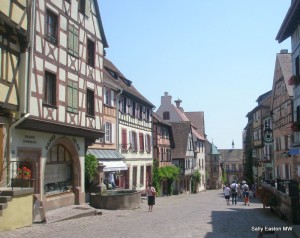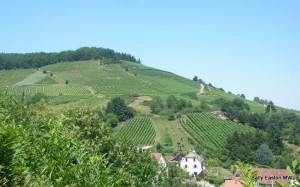Pinot noir ascendant in Alsace
There’s a growing excitement about pinot noir in Alsace, as a small groundswell of producers is increasingly garnering acclaim for their wines.
Pinot noir has always been allowed in the Alsace appellation, though not in the Alsace Grand Cru appellation. This latter category has (thus far) been reserved for wines from muscat, riesling, pinot gris and gewurztraminer, from 51 specific Grand Cru sites.
Moreover, pinot noir is the only permitted black cultivar under Alsace legislation. And it accounts for a notably sizeable 10% of the vineyard area, especially considering it’s not regarded as one of the ‘noble varieties’ that are allowed to be made into Grand Cru. It is, though, used to make sparkling wines – Crémant d’Alsace.
History provides some reasoning for pinot noir’s exclusion from Grand Cru status. Clearly the grape variety is of the highest quality order, so it can’t have been excluded on the basis of inferiority. But when the Alsace Grand Cru appellation was created in 1975, pinot noir was likely not really considered an ‘important’ cultivar at that time.
Shortly after 1975 – the late 1970s – marked the beginning of a change of fortunes for, and interest in, pinot noir in Alsace. In the 1970s the ‘traditional’ Alsace style of pinot noir winemaking was more akin to white winemaking, where maceration on the skins to extract colour and tannin wasn’t done so much, and the freshness of high acidity and primary fruit were more typically desired hallmarks. Wines were more likely to resemble rosés, which could be chilled for village summer parties. This has all changed.
During the late 1970s a trickle of producers started making their way to Burgundy and learning about serious pinot noir production. Foulques Aulagnon of the Alsace regional wine body said “people like René Muré [of Domaine Muré], returning from stages in Burgundy, tried the Burgundy style – with colour, and barrels.” Similarly, Domaine Albert Mann have been using traditional Burgundian techniques since 1993.
So this latest generational change in pinot noir production came after the creation of the Grand Cru. Some pinot noir is still made akin to a white wine where the axis of balance lies along acid-fruit, but increasingly, producers are making serious pinot noir, with modest oak framing, richer colour and greater density of character and longevity.
In addition to this long commitment of a handful of producers to building the reputation of pinot noir in their region, more recent factors are helping spread the word. Undoubtedly, generally in cooler, northerly latitude (in the northern hemisphere) regions a bit of climate change warming over the last generation is helping to make life a little easier for high quality pinot noir production. Added to which, pinot noir is generally in an ascendency and Alsace is now well placed to jump on that particular bandwagon. Plus Alsace has not been immune to the global spread of Burgundian pinot noir clones, a point quickly made by makers of modern incarnations of new world high quality pinot noir.
How to distinguish these high quality pinot noirs? We know that pinot noir is arguably the ultimate in site specific cultivars, and can reflect well its growing location. Alsace has some great sites, or lieux dits, as they are often known in France. Sometimes these sites happen to be the Grand Cru appellations. And Grand Crus are supposed to represent ‘terroir wines’, where site can be expressed more than pure varietal definition – another modern wine trend.
But, only the four permitted grape varieties, when grown within the boundaries of Grand Cru appellations, qualify for labelling as Grand Cru. As is happens, any of the other cultivars grown in Alsace can be grown in the Grand Crus – these just are not allowed to be labelled as Grand Cru; they have to be labelled ‘straight’ Alsace AOP. The reality in the vineyard means pinot noir may long have been planted in one or two Grand Cru vineyards – even before they became Grand Crus. It’s just that after 1975, they couldn’t be labelled as coming from that particular vineyard/Grand Cru.
Producers have been rather ingenious in finding a way around this, in a way that enables consumers (once they know) to identify which pinot noir has been grown in Grand Cru vineyards. Some producers use a letter (typically the initial letter of the Grand Cru vineyard name) after the grape variety to indicate a pinot noir wine that has come from a grand cru site. Thus Domaine Muré’s “Pinot noir V” comes from the grand cru Vorbourg; Domaine Albert Mann’s “Pinot noir Grand H” comes from Hengst and Domaine Albert Boxler’s “Pinot noir S” is from fruit grown on Sommerberg. Whilst not pinot noir, Josmeyer‘s Pinot Auxerrois H Vieilles Vignes follows the same principle, originating in the Hengst grand cru. Explanatory back labels are another option, but not all producers use back labels.
It is hoped things might become simpler … such is the growing interest in Alsace pinot noir that an application has been made by Alsace growers proposing pinot noir be allowed for the production of Grand Cru appellation wine – notably for Vorbourg and Hengst. It is entirely possible, in the next few years, the first Alsace pinot noir grand cru could be allowed to be openly labelled as such.
My visit to Alsace in July 2015 was sponsored by CIVA.
Comments
2 Responses to “Pinot noir ascendant in Alsace”






February 17, 2016 at 9:09 am
It’s a great recap of the situation but,
too bad the article doesn’t mention the viticultural efforts that have lead, together with the return of PN on Grand Cru or lieu-dit sites, to the emergence of world-class PN in Alsace.
10% of PN planted is a lot, but the vast majority is used to make crémant with yields that can reach 80 to 96 HL/hectare.
Winemaking techniques, cultivar optimization and single-vineyard sourcing are not the only conditions it takes to produce a great Pinot Noir. It also takes gutsy economical concessions in a region where nearly nobody is yet willing to pay as much for a Grand Cru Pinot Noir as they would for a high-end village Burgundy !
February 17, 2016 at 2:11 pm
Apart from climate change, price seems an important factor in the developments. As a Burgundy Pinot Noir easily can cost Euro 35,= and more, Alsace Pinot Noir fills in the lower price range, where once Burgundy PN used to be.
A lot of Alsace Grand Cru’s and Pinot Noirs are of great quality but the market is not yet used to price levels as “normal” in Burgundy.
It would be good if the market would get used to paying a little more for Alsace Grand Cru’s though and also to have a PN Grand Cru for a good price. The Alsatian wine makers deserve it.